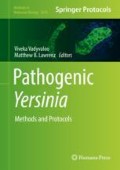Abstract
Primary pneumonic plague occurs when Yersinia pestis is inhaled into the lower respiratory tract where it invades the alveoli and grows. Rapid bacterial growth eventually elicits a neutrophilic inflammatory response that is ineffective and damaging, leading to accelerated progression of disease. In the laboratory, modeling of primary pneumonic plague can be accomplished by instillation of bacterial culture in the nares of anesthetized mice and rats. Although primary pneumonic plague can develop from this method, variability in dosing and side effects of anesthesia can complicate data interpretation. In contrast, aerosol challenge models allow for well-controlled studies of pneumonic plague with minimal experimental bias and unwanted side effects. For these reasons, antibiotic testing and the licensing of new treatments depend on efficacy data generated from aerosol delivery of Y. pestis in order to more accurately model transmission and the early stages of human pneumonic plague. In order to meet this need, we have extensively characterized pneumonic plague in mice and rats challenged by nose-only exposure to Yersinia pestis. With this approach, simultaneous challenge of large cohorts of animals, gently restrained and not anesthetized, assures safe, well-controlled, unbiased, and uniform infection. In this chapter, we present a standardized method for reproducible aerosol delivery of wild-type Y. pestis to rodents for experimental models of primary pneumonic plague.
Access this chapter
Tax calculation will be finalised at checkout
Purchases are for personal use only
References
Turner P, Brabb T, Pekow C, Vasbinder M (2011) Administration of substances to laboratory animals: Routes of administration and factors to consider. J Am Assoc Lab Anim Sci 50(5):600–613
Hofstetter C, Flondor M, Boost K, Koehler P, Bosmann M, Pfeilschifter J, Zwissler B, Muhl H (2005) A brief exposure to isoflurane (50 s) significantly impacts on plasma cytokine levels in endotoxemic rats. Int Immunopharmacol 5:1519–1522
Christopher A, Ochoa S, Krushansky E, Francis R, Tian X, Zahid M, Munoz R, Lo C (2014) The effects of temperature and anesthetic agents on ciliary function in murine respiratory epithelia. Front Pediatr 2:111
Gargiulo S, Greco A, Gramanzini M, Esposito S, Affuso A, Brunetti A, Vesce G (2012) Mice anesthesia, analgesia, and care, Part 1: anesthetic considerations in preclinical research. ILAR J 53(1):E55–E69
Gater S, Peters K, Kocsis A, Dhariwala M, Anderson D, Anderson P (2012) Host stress and immune responses during aerosol challenge of Brown Norway rats with Yersinia pestis. Front Cell Infect Microbiol 2:147
Surgalla M, Beesley E (1969) Congo red-agar plating medium for detecting pigmentation in Pasteurella pestis. Appl Microbiol 18(5):834–837
Guyton A (1947) Measurement of the respiratory volumes of laboratory animals. Am J Phys 150:70–77
Mainelis G, Berry D, An H, Yao M, DeVoe K, Fennell D, Jaeger R (2005) Design and performance of a single-pass bubbling bioaerosol generator. Atmos Environ 39(19):3521–3533
Acknowledgments
We are grateful for excellent BSL3 assistance from Jacob Stockton. This work was supported by NIH/NIAID Public Health Service Award #R21AI133450 (DMA and PEA).
Author information
Authors and Affiliations
Corresponding author
Editor information
Editors and Affiliations
Rights and permissions
Copyright information
© 2019 Springer Science+Business Media, LLC, part of Springer Nature
About this protocol
Cite this protocol
Anderson, P.E., Olson, R.M., Willix, J.L., Anderson, D.M. (2019). Standardized Method for Aerosol Challenge of Rodents with Yersinia pestis for Modeling Primary Pneumonic Plague. In: Vadyvaloo, V., Lawrenz, M. (eds) Pathogenic Yersinia. Methods in Molecular Biology, vol 2010. Humana, New York, NY. https://doi.org/10.1007/978-1-4939-9541-7_3
Download citation
DOI: https://doi.org/10.1007/978-1-4939-9541-7_3
Published:
Publisher Name: Humana, New York, NY
Print ISBN: 978-1-4939-9540-0
Online ISBN: 978-1-4939-9541-7
eBook Packages: Springer Protocols

